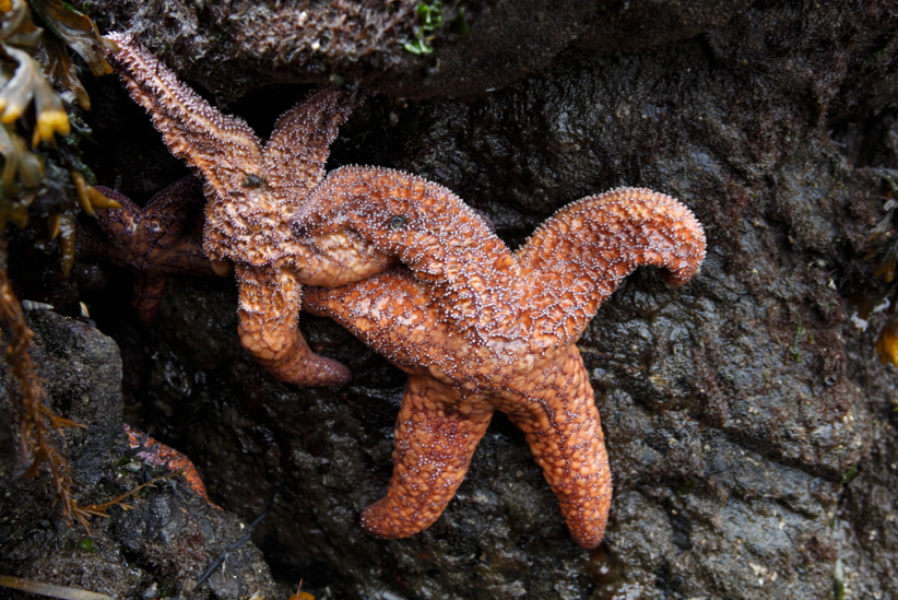
Deflated ochre stars in Puget Sound showing signs of sea star wasting disease, which has infected 20 species of starfish from Mexico to Alaska.
Katie Campbell / KCTS/EarthFix
During the height of the sea star die-offs in 2014, millions of stars up and down the West Coast were wasting away. At the same time, sea surface temperatures in the northeast Pacific Ocean were the warmest recorded in decades.
Scientists suspected a connection.
Now in a study published Monday, scientists are confirming that warm temperatures played a part in what's being called the single largest, most-geographically widespread marine disease that's ever been recorded.
Researchers analyzed logs from temperature sensors in Puget Sound and on the outer coast of Washington and compared them with extensive sea star monitoring data from surveys before, during and after the outbreaks. They found evidence that as water temperatures rose, so did the risk of starfish succumbing to the wasting disease.
They also conducted lab experiments, holding starfish in aquarium tanks at varying temperatures between 12 to 19 degrees Celsius. Starfish in warmer tanks died more quickly than those in cooler tanks. Juveniles took longer to show signs, but died immediately once lesions appeared.
"That was really direct evidence for the role of temperature at making them die at a faster rate," said Drew Harvell, a Cornell University professor who co-author of the study. Harvell also teaches at the University of Washington's Friday Harbor Labs on San Juan Island, where much of the field monitoring data was collected.

Marine epidemiologist Drew Harvell inspects sick sea stars in Washington's San Juan Islands.
Katie Campbell / KCTS9/EarthFix
Starfish can be stressed by warmer temperatures, which impacts their immune systems, making them more susceptible to disease. But that’s not all.
“It’s a double whammy because a lot of infectious agents replicate more quickly at warmer temperatures, so a host can get struck from both sides under warming conditions,” Harvell said.
The wasting disease has infected more than 20 species of sea stars from as far south as Mexico and as far north as Alaska. Some species, like the sunflower star, have been so hit hard in California, Oregon, Washington, British Columbia and southern Alaska that diver surveys since then have found very few survivors.
“That’s nearly its entire range. The last bit of its range that remains are in the Aleutians,” Harvell said. “So we’re pretty concerned about the well being of that species.”

Joel Elliott is a marine ecologist at University of Puget Sound. He used to reliably find large spiny pink stars (Pisaster brevispinus) like this in South Puget Sound.
Courtesy of Joel Elliott / University of Puget Sound
Harvell says she expects to see more evidence of the disease as the waters warm again this summer. She and other scientists hope to keep a close eye on water temperatures along the northern Pacific coast.
Researchers also found a correlation between the size of the sea star and wasting disease. Smaller stars seemed to have a greater chance of withstanding the disease than larger stars, said Joel Elliott, a marine ecologist and invertebrate zoologist with the University of Puget Sound, who co-authored the study.
Elliott, who has been monitoring starfish in South Puget Sound since 2005, said he used to reliably see hundreds of stars.
Now, very few stars remain. But in a low-tide survey last week, Elliott said researchers found evidence of ochre stars (Pisaster ochraceus) and mottled stars (Evasterias troschelii) that seemed to have survived the die-offs.
“They looked relatively healthy. Some looked like they had lost arms and were re-growing them,” Elliott said. “It’s possible that they dropped arms and were able to overcome the disease.”
The next step, Elliott said, is for researchers to look at the stars that have survived to see whether they are in fact immune to the disease and figure out how they managed to survive.